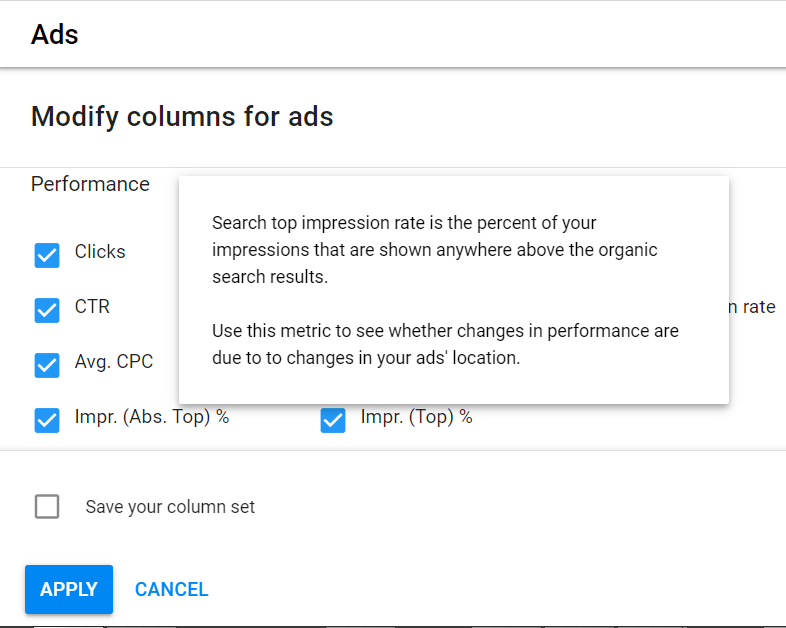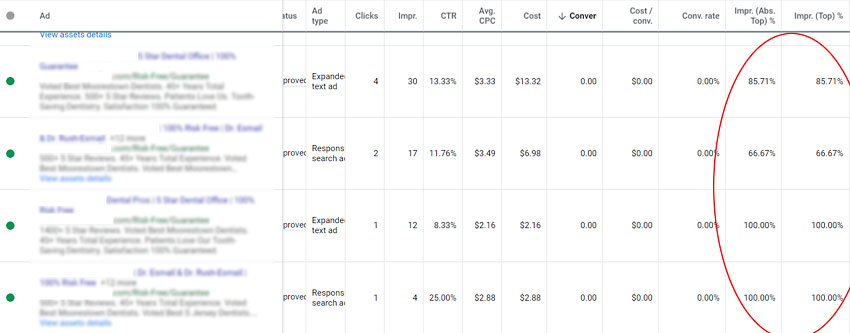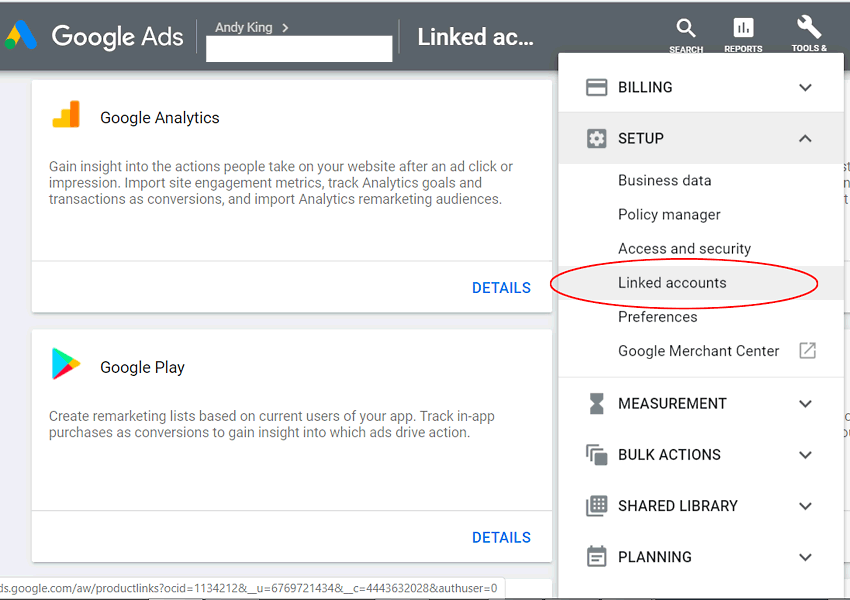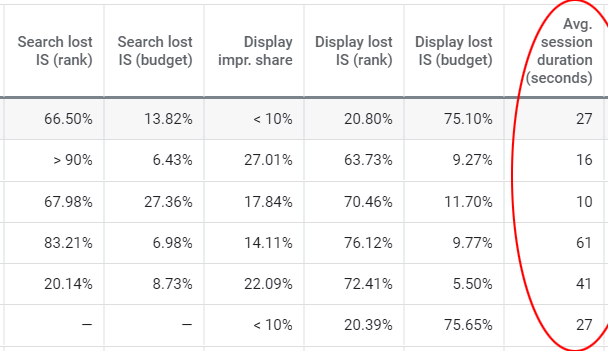In a previous article, we wrote about early warning signals that can help you optimize PPC ads faster using Phone Calls and PTR (phone through rate) data. In this follow-up article we explore additional metrics to help optimize PPC ads faster, including Impressions Top & Absolute Top, and Average Session Duration. Using these metrics can give you an early indication of the performance of text ads in search campaigns.
Average Ad Position vs. Impressions Top & Absolute Top
Google previously provided the average ad position (1.5 etc.) as an option in ad performance metrics (reached through the Columns icon under Performance). Google has replaced this metric with Impressions Top and Absolute Top (see Figure 1). These metrics show how prominently your ad appears above the natural search results.
Impressions Top is the percent of ads that appear at the top of the page, above the search results. Impressions Absolute Top is the percentage of ads that appear first above the search results.
You can add the Impressions Top & Absolute Top metrics to your ad display under Columns -> Performance (see Figure 2).
Typically Absolute Top is lower than Top, the ideal prominence would be 100% / 100%, which would mean that the ad shows above the search results 100% of the time, and is number one 100% of the time. Even before you get any clicks and CTR, you can quickly prune out lower performing ads by pausing ads that garner lower impression scores (say below 50%).
Average Session Duration
Another useful metric is the average session duration. Derived from Google Analytics, the average session duration shows how long the average session lasts in seconds. Google Analytics calculates this metric by dividing the total duration of all sessions during a specified time frame by the number of sessions during the same time frame. This metric shows how “sticky” and engaging your ads and landing pages are.
You can show the average session duration metric by linking your Google Ads account with the matching Google Analytics account (see Figure 3). To link up Google Analytics go to Tools & Settings -> Setup -> Linked Account and select Google Analytics (see Figure 3).
The average session duration can be shown for ad groups and individual ads (see Figure 4). We find that expanded text ads tend to have the longest session durations, while display ads have the shortest. Dynamic text ads and smart ads usually fall somewhere in-between.
Conclusion
You can use early warning metrics like average session duration and Impressions Top & Absolute top to quickly triage better ad text from lower performing ads. Even before clicks and conversions register for an ad, these three metrics will appear, allowing you to pause lower performing ads and enhance higher performing ads. The ultimate goal of course is to have high performing ads for all campaigns and ad groups which have high CTR and conversion rates, and lower cost per click and conversions.
Further Reading
- PPC Optimization: Abbreviate Ad Text
Abbreviating key phrases in PPC text ads can lower CPC and the cost per conversion. Our otherwise identical text ad with “Michigan” abbreviated to “Mich” decreased the cost per call by more than 35%, and increased the conversion rate by 33 percentage points. - PPC Optimization: Ad Text Position
Leading with benefits can improve PPC text ad conversion rates. We show a case study that improves conversion rates by 1.8X. - PPC Optimization: Ad Title Tweaking
Learn how small changes in ad text can make big changes in performance. By varying our Ad Title text we improved ad position from 2.4 to 1.0. - PPC Optimization: Age Range Targeting
You can target specific age ranges in Google Adwords to optimize conversion rates. By tweaking the bids on high performing age ranges you can tilt your campaigns to those folks more likely to convert. - PPC Optimization: Average Income Targeting
Targeting your desired audience within particular geographic area using income is a powerful tool you can use to improve your conversion rates. Average household income is just the first demographic that Google has rolled out for that purpose. Coming soon are gender, age, and parental status which could be used to further refine your campaigns. - PPC Optimization: Be Specific
Using specific copy in your PPC ad text can improve conversion rates. Giving searchers ad text that more closely matches their search queries gives them results that more closely match their goals. - PPC Optimization: Call Only Ad Extensions
Adding ad extensions to Call Only campaigns can boost click-through and conversion rates. - PPC Optimization: Dayparting Display Ads
Dayparting your PPC ads can make your campaigns more efficient. Learn how to schedule your display campaigns for the times when people are most likely to convert. - PPC Optimization: Display URL Expansion
By including keywords or calls to action in your display URLs you can boost text ad performance in Google Adwords. This article shows a real-world example of display URL optimization. - PPC Optimization: Early Warning
In Google Adwords, you can use phone call metrics as an early warning system to optimize text ad conversion performance. Avoid scary PPC ad spend using fast-reported phone calls. - PPC Optimization: Exluding ZIP Codes by Income
Excluding lower income ZIP codes is a more precise way than Google’s household income method. This article shows how to exclude lower income ZIP codes within your target geography in Google Ads. - PPC Optimization: Experiments in Punctuation
By varying the punctuation and plurals within your text ads, you can optimize their conversion rate and cost per conversion. This article shows a case study of call only text ad optimization. - PPC Optimization: Gender Targeting
In Google Adwords you can optimize conversion rates using gender targeting. Learn how to squeeze more leads out of your PPC spend by targeting high performing demographics singly or in combination. - PPC Optimization: Strange Attraction
Learn how using strange attraction in your ad text can lower CPC and boost CTR and conversions. Grab attention with letter and symbol combinations to optimize PPC campaigns. - PPC Optimization: Using Call Only Ads in Search Campaigns
Learn how to mix call-only ads with text ads in Google Ads. Boost quality scores and leads with this PPC ad mixing technique. - PPC Optimization: Wordplay and Humor
Humor and wordplay can make your advertising stand out from the crowd. Unexpected word combinations and humor attract valuable attention and can garner higher PPC click-through and conversion rates. - PPC Optimization: ZIP Code Targeting
Learn how to add ZIP code targeting to your PPC campaigns to boost conversion rates. By optimizing the performance of individual demographics and locations, you can improve conversion rates to squeeze more leads out your AdWords spend. - Supercharge Your Call Only Ads with Ad Extensions
Google shows which ad extensions can be used with Call Only ads.




